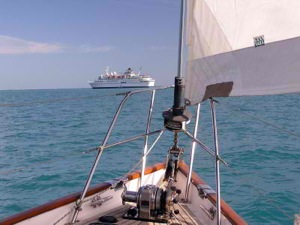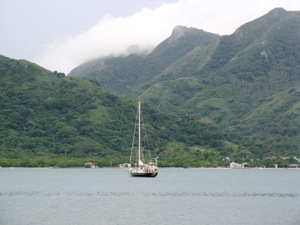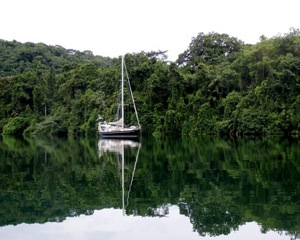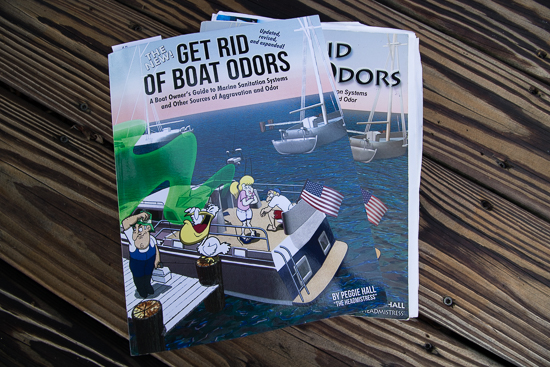No one, myself included, is going to want to hear this, but the only way to thoroughly clean a boat diesel tank is to get down on your hands and knees and scrub. Otherwise, you can almost guarantee that you’ll get sludge and gunk build up in the tank that will eventually impact your diesel no matter how many other preventative measures you try.
You may or may not be aware that algae grows in diesel. It takes air and water to allow algae to grow, and if the tanks aren’t completely full all the time, air is inside the tank, allowing condensation (i.e. water droplets) and algae. Eventually (and I’m not talking a really long time) some algae will die and start to puddle in the bottom of the tank as black crud. We like to use our diesel just enough to get in and out of a marina. But it can sit for long periods of time … even while we’re aboard … without being used. Until our passage year all the way from Colon, Panama to SW Florida, we rarely used more than one tank of diesel an entire cruising season. This means we’re always going to have black crud. And if you’re out in bouncy seas — or any boat movement for that matter, that crud’s chief ambition in life is to block your fuel filters, shutting down the diesel. This is actually a very good thing, although no one likes to have their diesel shut down, but without the fuel filters clogging, the crud would be able to get directly into the diesel engine creating MUCH more havoc!

So keeping the tanks clean is of optimum importance and something you should have on your list EVERY season when you return to the boat – If you completely emptied, cleaned and dried out the tank before leaving, check it anyway. Friends remove all their diesel each season they return to the boat, remove the inspection ports and scrub the tanks completely clean and dry, then pour the fuel back in slowly through a baha filter.
Aboard Winterlude, we have two stainless diesel tanks, approximately 30 gallons each. The tank under the starboard quarterberth we think was probably added by a prior owner, so it’s “relatively” new — the boat is a 1985 Passport 37. That tank has an inspection port and is “relatively” easy to reach and clean. I say relatively because there’s only one inspection port at the forward end of the berth — i.e. nothing tucked back in the far inaccessible corners. But since the intake is in the front corner of the tank and the tank is only between 12″ – 18″ in the deepest spot, the sludge accumulates where we can reach it to clean it … for the most part. There’s a batten dividing the tank in half, so to clean behind the batten would require an additional inspection port be cut into the tank.
Note that when I say “clean”, it’s not a “scrub” in the traditional sense of the word. After searching online and talking with other cruisers, we don’t use any “cleansing agent” such as Joy or any kind of “cleanser” in the tank. Rather first we use an old sponge to soak up the remaining diesel and as much crud as we can get, then we use old rags or papertowel to mop up the rest. If we used a real “cleanser” some might remain despite our best precautions and heaven only knows what a catastrophe that could cause!
The original tank is centerline under the salon table, down into the keel. The unfortunate part is the batten is horizontal and totally prevents any kind of access underneath it. There’s no way to cut an additional inspection port in this tank and we shudder to think what kind of sludge and gunk buildup might be way down deep where we can’t see and can’t reach.

Before we left Annapolis to cruise to Florida in 2001, on the recommendation of Chris Oliver, our diesel surveyor and subsequent diesel mechanic, we had both tanks “steam cleaned”. They siphon all the diesel out and go in with very impressive looking equipment to steam clean the tanks. It wasn’t cheap and who knows if it did a thing, but we didn’t have any diesel shut downs on the way to Florida based on gunk in the filters, so I guess it must have helped.
We were in Punta Gorda Florida from November 2001 until we left the U.S. in October 2004, so 3 years. During those three years, we spent 50 nights a year aboard – no easy feat since David lived in Illinois and I lived in Indiana, but we got acquainted with the boat and trials and tribulations of our Nanni Kubota diesel. Since we could not easily clean the center diesel tank, Diesel Don recommended we consider a fuel polishing system to circulate the diesel fuel through additional GIANT size Racor filters. He designed and installed the system which has been a valuable addition. Also, just before we left, he recommended we steam clean those tanks one more time. So we did.
Imagine our surprise when, just a few months later, motorsailing along the reef just outside San Pedro Belize (Ambergris Caye) when the diesel just locked up and quit. We couldn’t get in that zig zag tricky pass without it and after an overnight from Bahia De La Ascension, southern Caribbean Mexico, we were not exactly perky and excited to solve this new crisis. Looking at the charts, we found the next easy entry through the reef would be the main ship channel into Belize city – which since there was almost no wind, would guarantee another overnight – and a tricky one at that to keep from getting swept onto the reef with almost no wind and no diesel.
Luckily, David dove below, checked the strainer, nothing that would shut down the diesel, and then started in on the filters. We have 2 filters before the diesel and both were clogged completely. In literally the overnight from the passage, we checked those filters before departing Bahia De La Ascencion.

Once safely anchored inside the reef at San Pedro, Belize, we ran the fuel polisher until all the fuel had been polished at least twice. Our fuel polishing system also allows us to pump diesel from one tank to the other, helpful while cleaning so we don’t have to siphon or pump all the diesel out of the tank into jerry cans (unless both tanks are too full).
Recently we’ve been only using the starboard fuel tank under the quarterberth since we can actually access some of it to clean. But before we leave the U.S. again in the spring, we’re going to try and jerry-rig a way to completely clean that center tank. Some tasks are just more challenging than others!
Does anyone have any tips for us to clean that center tank with the horizontal baffle blocking the way to see the midlevel to bottom of the tank? So far this project has yet to be done 100% to our satisfaction, so we’re all ears! THX! J














Algae cannot grow without sunlight. Threre is no algae in a diesel fuel tank. What you think is algae is asphaltene clusters forming from the petroleum solvents leaching out of the fuel. This occures from fuel that has been sitting for long periods and is common with recreational vessels, standby generators and farm equipment. It does not occur with commercial vessels or trucks which use a lot of fuel. To some degree it can be prevented by adding petroleum solvent back into the fuel. Pri-D is about 95% petroleum solvent. MIcrorganisms (bugs) can also grow in diesel fuel if there is water present which there often is.
It is important to clean diesel tanks periodically because in due time sludge will accumulate especially when your boat is not used for a long period. It is also the best time to check if there there is any water seeping through, corrosion and the condition of the inner surface of the tank. If you decide to get diesel fuel tank cleaning services, make sure you choose the most experienced and knowledgeable service company.